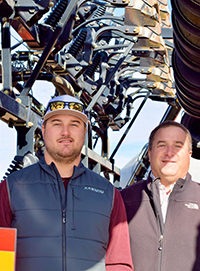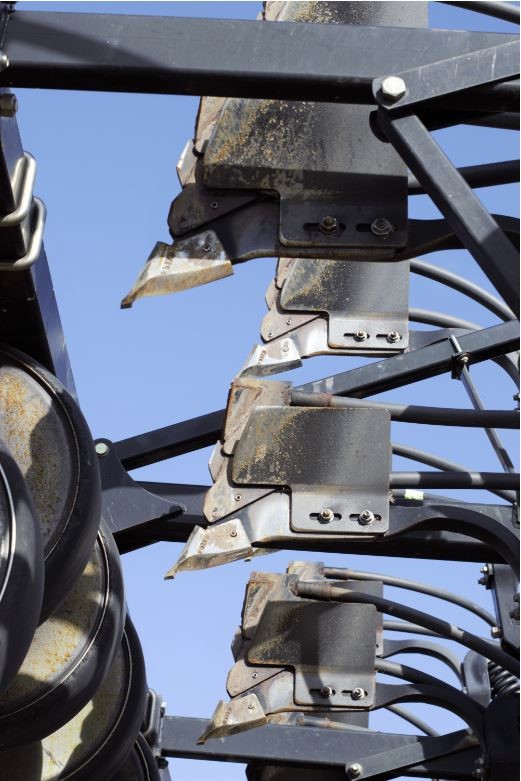 In an area where tillage is common and minimal annual rainfall is expected, one father-son duo is finding success doing things differently.
In an area where tillage is common and minimal annual rainfall is expected, one father-son duo is finding success doing things differently.
Washington wheat farmers Remie DeRuwe and his son, Jacob, adopted a no-till production system in 2011 and have never looked back.
“I’m one of those guys who is willing to try stuff. I wanted to prove that no-till wouldn’t work here, but low and behold, our first no-till wheat crop was our best crop ever for that field,” Remie DeRuwe says. “We are farming thousands of acres of no-till in an area that’s supposedly not suited for no-till.”
A Multiyear Production Plan
Farming across several microclimates, the DeRuwes average between 7 and 15 inches of rainfall each year, depending on field location. That difference in rainfall amounts can result in a 10- to 15-bushel yield difference.
The father-son team plant no-till winter wheat every other fall, followed by a chem fallow rotation. That means about 13 months between crops to build soil moisture.
“With this rotation system, instead of raising wheat on 7 inches of rain, we might actually be raising wheat on 12 inches of moisture,” Remie says.
The elder DeRuwe says their production system may cost more than planting winter and spring wheat conventionally. However, Remie contends they are covering a lot of ground efficiently. With 30,000 acres of farmland spread across three counties and only four full-time employees, it would be futile to argue against him.
“Other conventional systems with multiple tillage passes work. They do the job, and there is no doubt about that. But our no-till system is more sustainable,” Remie says. “We are trying to do things differently. We are looking at long-term gains. Plus, you can farm twice as many acres as your dad did with this no-till system.”
In addition to the efficiency of their no-till production system, their focus on residue management helps retain available soil moisture, which is critical in low-rainfall areas.
Much of the farm’s wheat residue is mowed to a shorter height, allowing it to form a mat over the furrow. This creates a residue barrier of organic material, minimizes dust and maintains soil moisture.
“Our light soils are especially susceptible to wind erosion. It is important that we conserve the top soil we have,” Remie says. “Even our good ground has only 1.8% organic matter, which is double that of the average organic matter for our area.”
Different From the Start
Eliminating tillage isn’t the only thing the DeRuwes are doing differently. The DuRuwes have adopted 15-inch row spacing for wheat and can seed about 950 acres of wheat per day.
To ensure success with their no-till system, the pair redesigned existing 60- and 70-foot-wide Case IH drills to their spacing requirements and added the capability to apply fertilizer via the drill at planting. They also swapped out the drill’s existing points for specially created narrower models.
“The existing points were too wide. We needed to build furrows that would protect soil spacing without opening up too much ground in the process,” Jacob says.
Season-Long Protection
Although the additional crop residual resulting from the DeRuwes’ no-till production system helps minimize Russian thistle and kochia populations, those weeds as well as marestail and prickly lettuce remain a concern when developing weed control programs.
“Kochia was one we couldn’t kill a few years back, and now it has been replaced by prickly lettuce as our main concern,” Jacob says. “We are also selecting those summer weeds with our no-till system.”
Their first herbicide treatment in the spring is aimed at cheatgrass and volunteer weeds, followed by Embed® Extra herbicide as their second chem fallow spray targeting broadleaf weeds.
“It doesn’t matter if you are traditional fallow or no-till, volunteer weeds need to be controlled early. Otherwise, you may have a season-long fight with weeds, and loss of valuable seed zone moisture,” Remie says. For in-season winter wheat, the pair are spraying a tankmix of WideMatch® herbicide, 2,4-D and Aproach® Prima fungicide when wheat begins tillering. Depending on pressure, they may add PowerFlex® HL herbicide to the mix for cheatgrass control.
After testing out WideARmatch® herbicide on one field in March 2020, the DeRuwes will likely convert a portion of their acres from WideMatch to WideARmatch in 2021.
“Moving to WideARmatch adds another active ingredient to the mix, and that third active ingredient will definitely beef up our weed control program,” Remie says. “It will give us more bang for our buck and will improve our resistance management program.
“We are trying to get over thousands of acres over a short amount of time. Adding that third active ingredient in there in one tank saves time and picks up a broader spectrum of weeds,” he adds
Another advantage he sees with WideARmatch and Aproach Prima is the availability of larger container sizes.
With a 120-foot boom on their spray rigs, the DeRuwes are treating 1,200 to 1,500 acres of wheat per sprayer each day.
“We can leave the yard with shuttles (bulk tanks) full in the morning and we don’t have to go back to refill, saving us valuable time. When we’ve got that window available to spray, we’ve got to go,” Remie says.
For disease control, the DeRuwes spray Aproach Prima proactively for rust control and for overall plant health.
“This year, when rains increased disease pressure, we didn’t need a respray. Aproach Prima carried the day,” Jacob says. “Aproach Prima is our insurance policy. It buys us protection against disease. Even if we must spray those fields again, they don’t blow up, and we haven’t lost yield potential. It brings peace of mind to the table.”
Aproach® Prima, Embed® Extra, PowerFlex® HL, WideMatch® and WideARmatch™ are not registered for sale or use in all states. In Florida, refer to the 24(c) Embed Extra product specimen label for restriction in certain counties. Embed Extra is labeled under FIFRA 24(c) for broadleaf weeds in citrus. Contact your state pesticide regulatory agency to determine if a product is registered for sale or use in your state. Always read and follow label directions.
The More You Grow
Find expert insights on agronomics, crop protection, farm operations and more.
